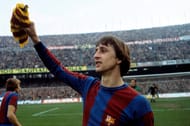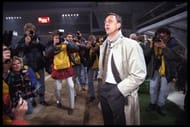The central figure of many teams, Johan Cruyff was an enigma when people talk about his presence on or off the field.”As long as you look at certain way of playing, everybody can play”, Cruyff huge success across many teams he played for and managed acted as a pedigree to a lot of youth players. Like an archaeologist, he always managed to find the hidden treasures of the beautiful game.
A star is born
An Ajax academy product, Cruyff integrated the total football at Ajax, pioneered by John Reynolds in the early part of the 20th Century. Reynolds tactics were well received by his player Rinus Michels who went on to manage Ajax and Cruyff. Michels understanding of the total football system helped Cruyff immensely as he was often deployed as the free man and performed the perfect combination of intelligence and skill. He mastered the position they now call the false 9.
An early break in the Ajax senior team at the age of 17 started his sensational career, not to forget a goal on debut. At such a tender age, Cruyff was already being credited for the vision and decision making abilities that would define him and sum up his extraordinary footballing venture.
The 1965-66 season saw Cruyff getting mature as a player and scored a total of 25 goals in all competitions. “An 18 year old saw everything on the ground which is absolutely astonishing” as stated by the late Rinus Michels. Ajax went on the win the Eredivisie 3 consecutive time during 1965–66, 1966–67,1967–68 era.
The Ajax Golden Era
In 1969–70 Michels and Cruyff were going places as they reached the finals of the European Cup with the brand of attacking and pressing football. The Cruyff led team started asking questions to some of the major teams in the world and despite their heavy loss in the finals at the hands of Milan; Michels knew that the fault didn’t lie in the football system they adopted, but the inexperience of the players playing the bigger teams.
Beginning of the Ajax golden era was no fluke. Michels faith in making Cruyff the fulcrum of the team started to pay dividends. It was a master stroke; as Ajax went on to win 3 back to back European Cups in the early 1970’s, a feat that is matched by Bayern and only bettered by Madrid.
A small club then from the east of Amsterdam, Cruyff’s brilliant understanding of the tactics which was laid down by Michels and later Kovács was crucial in producing the results that propelled this Ajax team to go down in the history as the team that outplayed most of the teams and dominated the European football.
Cruyff, the best player in the world moves to Barcelona
Problems behind the curtains and an angry Cruyff decided to move away for a new challenge and combine again with his mentor and former manager Rinus Michels at Barcelona. The two times Ballon d’Or winner then was to become the most influential man to have set foot on the Catalan lands.
Arguably the best player in the world, Cruyff helped a struggling Barca reclaim the La Liga title after 14 long years. His arrival not only changed the shape and system of the way Barca played, but also provided the missing puzzle in their long lost armour. Cruyff went on to earn iconic status with fans, scoring a well anticipated Phantom Goal against Athletico Madrid.
He was also instrumental in the mesmerizing display of total football against Barcelona’s El Clasico rivals Real Madrid. A strong Madrid team was humiliated on their home turf and thrashed 5-0. This sent a worldwide shock wave that how efficient can a tactical formation combined with pressing play can change the course of the game.
Netherlands golden generation
Just after qualifying for the 1974 world cup, Rinus Michels was called up by the Dutch national team to take over as the head coach. It was no mystery that this team would be led by the scintillating Johan Cruyff. Cruyff the most attentive pupil of Michels did not disappoint either. His leadership influenced Netherlands to march as far as the World Cup finals.
In the second round, the Dutch faced a buoyant team of Argentina and the mighty Brazilians. A possession cultured Argentina hardly got a shot on goal and were defeated 4-0 by the promising La Oranje. Possession play is certainly one aspect of total football but what Argentina missed was the pressing game that Netherlands played.
One of the most important aspects of total football is what strategy a team goes with, when they don’t have the ball. While Argentina kept most of the possession, they hardly entered in the final third of the Dutch defence line. Cruyff once again showed how his leadership helped the Netherlands keep their temperament and come on top of the Argentine’s. Cruyff attacked like a falcon and retraced his opponents magnificently. The biggest challenge of course was the game against Brazil and Cruyff was at his best as he scored both the goals in a 2-0 win.
A brilliant run in the German penalty box by Cruyff was met with a foul and Netherlands went ahead. The Germans came back strongly and took a 2-1 lead just before the half time. The game finished with the same score line. This Netherlands team was perhaps the best team to have not won the World Cup.
A disappointing end for the team who played with galloping instincts, nonetheless Cruyff’s effort was rewarded, as he won the Golden Ball. Michels and Cruyff reunited and the magic worked yet again just like it did at Ajax and later Barca. Total Football had been seen at the world cup stage once again.
It brought back the memories of the Hungarian national team of the 1950’s.Later that year after bidding farewell to international duties, Cruyff went on to win his 3rd Ballon d’Or. However, the talking point of that year was the Cruyff turn. This special skill by Cruyff was pulled at the world cup’s first round game against Sweden. It was a sublime display of the skills he could come up with.
An ageing Cruyff makes a smashing deal with Los Angeles Aztecs and leaves the Catalan club
At the age of 32, Cruyff left the Catalan Club and joined hands with the Los Angeles Aztecs of the North American Soccer League. A year later he moved to play for the Washington Diplomats. After a small spell at Levante, Cruyff decided to move back with Ajax.
Homecoming
His final years as a football player ended with 3 consecutive Eredivisie titles, 2 with Ajax and one with Feyenoord, which was as a shocking move. His return to Ajax in 1981 saw the fans witness another skill from his bag, when Cruyff combined in a one-two with fellow striker Olsen to score a memorable penalty.
Two seasons later, Ajax disagreement with Cruyff to renew his contract sparked a feud between the parties and Feyenoord who were seen as Ajax arch rivals cashed in. Cruyff called it a day at the end of the season. This opened the door to the new chapter of his footballing career.
Cruyff the professor
As a manager, Johan Cruyff started with his boyhood club Ajax. Although he was not hugely successful, his ideologies and playing formation was well accepted by the Ajax club. After his departure, Ajax won the 1995 European Cup with the 3-1-2-1-3 formation that was laid down by Cruyff. He influenced the likes of Marco van Basten, Rijkaard, Bergkamp and many more during his time as the Ajax manager.
Role model at Barcelona
His most significant managerial contribution came out on his return to Barcelona. Under his helm, Barca started to form a youth academy that no team in the world had seen earlier. La Masia as it is called, encourages players to not just play football at an early age but also groom and build them in playing a systematic brand of football.
The crop of players that come out of the Barca academy have ideas similar to Cruyff’s understanding and an extra effort to make them understand the basic game play tactics was not needed any further, once these players broke into the senior squad. As Cruyff was the most ideal student Michels had, Pep Guardiola the future architect of the game became Cruyff’s biggest prodigy.
Barcelona’s dream team
With Barcelona Cruyff won 4 consecutive La Liga titles and Barca landed up their maiden Champions League Trophy. Cruyff was the inventor of the greatest football tactics that Barca plays and during early 1990’s Barca started to enter their golden phase in football. The culture still follows at Barca and the brand of total football became false 9 but with similar attributes in the game play that once Cruyff played and preached.
One of the greatest footballers of all time ; a legend whose name will be always spoken around the likes of Pele and Maradona. A footballer, a manager and the greatest football architect of his generation, Cruyff’s contribution towards football, makes him one the finest ambassador the game witnessed. Indeed an immortal figure of football – Johan Cruyff.



